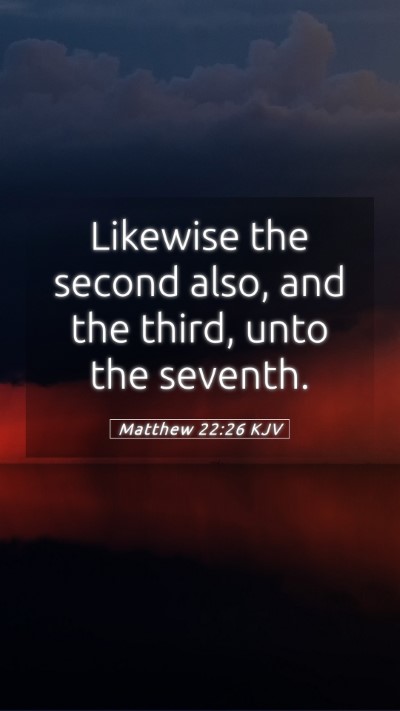Bible Verse Meaning and Commentary: Matthew 22:26
Verse: "Likewise the second also, and the third, unto the seventh." (Matthew 22:26)
Introduction
This verse is part of a larger discourse where the Sadducees, a sect known for denying the resurrection, challenge Jesus with a hypothetical scenario regarding marriage and resurrection. Matthew 22:26 emphasizes the unfolding of their argument as they continue to press their case against the teachings of Jesus regarding life after death.
Contextual Background
Historical Context: The Sadducees were influential Jewish leaders who rejected any form of resurrection and the teachings that accompanied it. Their challenge was strategic, aimed at discrediting Jesus in front of His followers. By presenting this scenario, they aimed to illustrate what they perceived as the absurdity of the resurrection concept.
Commentary Insights
-
Matthew Henry:
Henry notes that the Sadducees' question regarding the wife of seven men reflects a misunderstanding of the resurrection and highlights their lack of faith in the power of God. They assumed that life after death would mirror earthly existence, missing the transformative nature of eternal life.
-
Albert Barnes:
Barnes expounds that the Sadducees did not comprehend the nature of God's promise of eternal life. Their questioning reveals a reliance on human reasoning rather than divine revelation, showcasing their opposition to the teachings of Jesus regarding the afterlife.
-
Adam Clarke:
Clarke reflects on the theological implications of this argument, emphasizing that the Sadducees maintained a rigid interpretation of the law. He suggests that their line of questioning was an attempt to entrap Jesus in a dilemma, expecting Him to deny the Scriptures they held dear.
Theological Implications
This verse points to the necessary understanding of resurrection from a biblical perspective. Jesus’ teachings on resurrection reject earthly interpretations and focus on the spiritual transformation that occurs in eternal life.
Key Themes
- The Nature of God: The Sadducees lacked recognition of God’s omnipotence, especially regarding His power over life and death.
- Resurrection vs. Earthly Existence: This passage calls for a deeper understanding of what resurrection means in the context of eternal life.
- Faith: The Sadducees’ questioning showcases a need for faith beyond human reasoning and logic.
Practical Application
In our daily lives, understanding Matthew 22:26 encourages believers to prioritize spiritual truths over worldly logic. It serves as a reminder of the hope found in resurrection and urges Christians to live with an eternal perspective.
For Bible Study Groups
When discussing this verse in bible study groups, consider the following questions:
- What does this verse teach us about the nature of God?
- How can we apply the concept of resurrection to our lives today?
- What misconceptions do people have about the afterlife that we can address with biblical truth?
Cross References
- Matthew 22:30: Jesus clarifies the state of the resurrected—neither marrying nor given in marriage.
- Mark 12:23: The parallel account emphasizes the Sadducees’ challenge and Jesus' wisdom in responding.
- Luke 20:33-36: Further elaboration on the nature of the resurrected existence by Jesus, affirming His authority and divine truth.
Conclusion
Matthew 22:26 serves as a crucial verse for understanding the dynamics of belief in resurrection and eternal life. Through the insights of public domain commentaries, we can appreciate the depth and complexity of Jesus’ teachings and their implications for our lives today.
Keywords
This commentary has been crafted to assist in understanding the Bible verse meanings, explore Bible verse interpretations, and expand Bible verse understanding for personal growth and group study.


